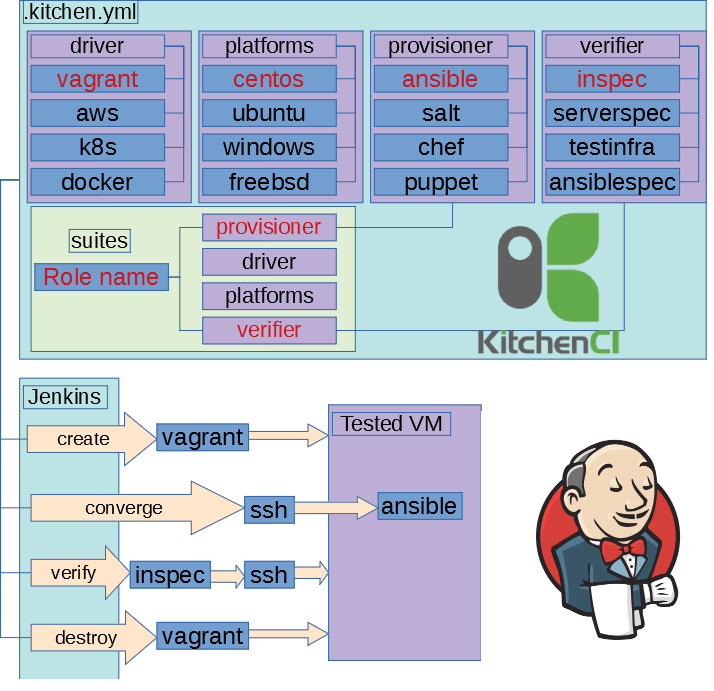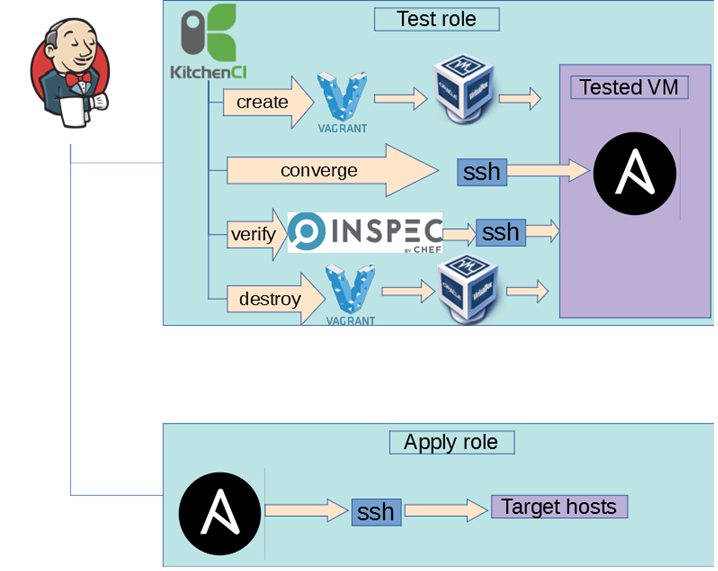
It is text version of the presentation 2018-04-25 at Saint-Petersburg Linux User Group. Configuration example locates at https://github.com/ultral/ansible-role-testing
I suppose that that you make configuration management, not bash. It means that you have to test it some how. Have you ever tested ansible roles? How do you do it?
How to do it?
In my case, we have:
- A lot of different ansible roles.
- Hyper-V hosts as a hypervisor.
- A private cloud with limited possibility to create VMs on demand.
- A proxy for internet access.
- Inability test ansible roles inside docker, because of a role = whole VM configuration.
- Decision to implement green build policy for git repository with ansible roles.
Let us compare existing solutions for testing.
| Name | Test Kitchen | Molecule | Create new |
|---|---|---|---|
| Language | ruby | python | bash/ruby |
| Watchers | 132 | 126 | 0 |
| Stars | 1413 | 1154 | 1 |
| Forks | 502 | 174 | 2 |
| License | Apache 2.0 | MIT | Any |
| Commits | 1929 | 1264 | 0 |
| Releases | 101 | 121 | 0 |
| Contributors | 109 | 82 | 5 |
| Name | testinfra | serverspec | inspec | Goss |
|---|---|---|---|---|
| Github | philpep/testinfra | mizzy/serverspec | chef/inspec | aelsabbahy/goss |
| Language | python | ruby | ruby | go |
| Watchers | 93 | 145 | 165 | 67 |
| Stars | 997 | 2105 | 1167 | 2170 |
| Forks | 138 | 361 | 330 | 156 |
| License | Apache 2.0 | MIT | Apache 2.0 | Apache 2.0 |
| Commits | 380 | 1854 | 4609 | 309 |
| Releases | 35 | 282 | 346 | 47 |
| Contributors | 43 | 110 | 159 | 31 |
We decided not to reinvent the wheel & get production ready solution. Our infrastructure team had strong ruby skills & great experience with ruby, as a result we chose Test Kitchen & inspec
Kitchen-CI

The main idea is to create a new VM, apply an ansible role & do some smoke tests.
Green Build Policy

Also, we implemented green-build policy. We ran tests for each commit into master branch & if tests are ok, when apply ansible roles.
Nested virtualization
As you remember, we had a private cloud with limited possibility to create VMs on demand. We decided to create VMs inside VMs.

First of all we tried to run Virtualbox x32 without nested. It was bad idea because of kernel panic. Also vast majority of our VMs in our infrastructure are x86_64, so we decided to continue research. As a result we decided to use nested virtualization. Hopefully it was supported by our host servers.
Faced issues
I was implementing testkitchen and faced with some issues.
Pass proxy settings from host into testkitchen guest VM
In some test suits, we configured proxy client settings inside VM created by testkitchen. However, proxy was not configured on testkitchen host & ansible cannot use extra variables with empty values
Solution: create erb template for setting default proxy if ENV variables is not set
<%= ENV['http_proxy'].to_s.empty? ? 'http://proxy.example.com:3128' : ENV['http_proxy'] %>Manage network settings via playbook
Some roles configure network interfaces. Test suit was looked like:
- Deploy network settings to VMs
- Reload network
- It is failed
Solution: add interfaces to VMs
Fail if suit cases contains "-" in name
Virtualbox can't use "_" in a vm name
Solution: rename suitcases "vm_" => "vm-"
Oracle test fails without "." at the end of VM name
We use role in production, however when we decided to test it, it was failed. We reproduced it.
I would like to show clue.
[root@vm-oracle vagrant]# getent ahosts vm-oracle
127.0.0.1 STREAM vm-oracle
127.0.0.1 DGRAM
127.0.0.1 RAW
[root@vm-oracle vagrant]# getent ahosts vm-oracle.
fe80::a00:27ff:febd:bd6a STREAM vm-oracle
fe80::a00:27ff:febd:bd6a DGRAM
fe80::a00:27ff:febd:bd6a RAW
10.0.2.15 STREAM
10.0.2.15 DGRAM
10.0.2.15 RAW
[root@oracle vagrant]# getent ahosts oracle.example.com.
192.168.128.182 STREAM oracle.example.local
192.168.128.182 DGRAM
192.168.128.182 RAWDo you have any ideas what is happening?
It is tricky bug:
- we enabled listen IPv4 only in oracle listener settings
- oracle used FQDN
- linux contains special database "myhostname" for resolving hostname, it is uses after /etc/hosts & dns resolving
- Vagrant created VM & updated
/etc/hosts
I'd like to clarify it a bit more:
What has happened in case vm-oracle?
- vagrant created vm
- vagrant updated
/etc/hosts(vm-oracle x2) - oracle listener listened IPv4
- oracle listeners resolved vm-oracle. & geted IPv6
- FAILED
What has happened in case vm-oracle.?
- vagrant created vm
- vagrant updated /etc/hosts ( vm-oracle & vm-oracle.)
- oracle listener listened IPv4
- oracle listeners resolved vm-oracle. & geted IPv4
- OK
OOM is coming
OOM randomly was killing VMs. Testkitchen was failed with strange errors.
Solution: increase RAM
Slow builds
It was working slowly
Solutions:
- Packer. Prebuilded vagrant box with common tasks
- Concurrency
Conclusion
On one hand, current implementation works, but on the other hand, there are some issues
- is not user friendly.
- we mix ruby & python.
- there is no indepotence check.
- it works slow.
- it is hard to trace logs at single job.
As a result, molecule & docker might be pretty interesting solution.


acmnu
Did you ever think about leaving Jenkins for something else? I mean it's painful to map complicated project's structure to Jenkins even with JJB or Pipelines.
ultral Автор
There is no way to move from jenkins. we have to use jenkins.